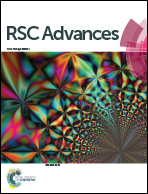Cytotoxicity in vitro, cell migration and apoptotic mechanism studies induced by ruthenium(ii) complexes
Abstract
Four new ruthenium(II) polypyridyl complexes [Ru(dmb)2(DHBT)](ClO4)2 (1) (DHBT = 12,14-dihydroxyl-4,5,9,10,11,13-hexaazabenzo[b]triphenylene, dmb = 4,4′-dimethyl-2,2′-bipyridine), [Ru(bpy)2(DHBT)](ClO4)2 (2) (bpy = 2,2′-bipyridine), [Ru(phen)2(DHBT)](ClO4)2 (3) (phen = 1,10-phenanthroline) and [Ru(dmp)2(DHBT)](ClO4)2 (4) (dmp = 2,9-dimethyl-1,10-phenanthroline) were synthesized and characterized. The cytotoxicity in vitro of these complexes was evaluated against human HepG-2, HeLa, A549, MG-63 and BEL-7402 cancer cell lines. The IC50 values of the complexes toward selected cell lines range from 14.9 ± 1.1 to 30.1 ± 2.7 μM. The cytotoxicity and the levels of reactive oxygen species were found to increase with increasing concentrations of the complexes. The complexes are sensitive to MG-63 cells and can inhibit the MG-63 cell migration. Morphological and comet assay studies show that the complexes can effectively induce apoptosis in MG-63 cells. Complex 2 inhibits the cell growth at the G0/G1 phase, whereas the other complexes exhibit the antiproliferative mechanism at the S phase in the MG-63 cell line. The complexes can downregulate the expression of Bcl-2 protein and upregulate the levels of Bad protein in MG-63 cells. The complexes induce MG-63 cells apoptosis through a ROS-mediated mitochondrial dysfunction pathway.


 Please wait while we load your content...
Please wait while we load your content...